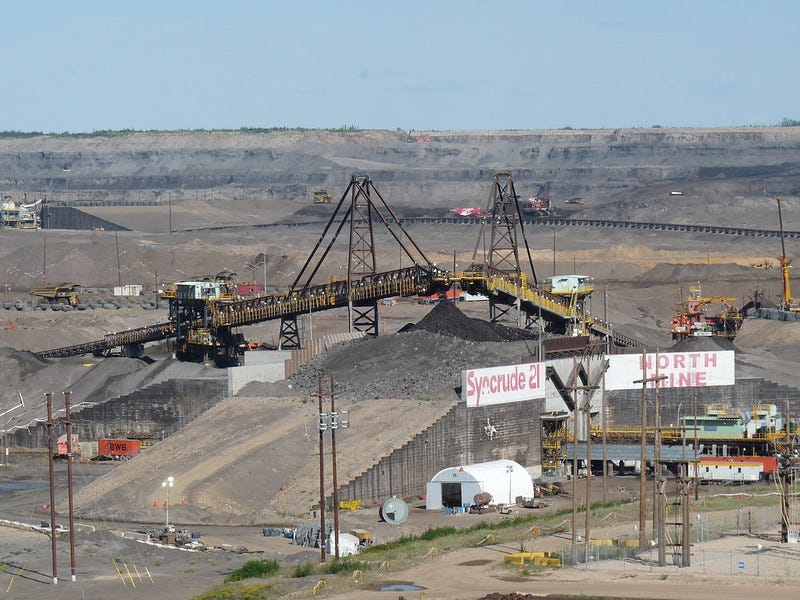Energy regulator hails oil sands' increased freshwater consumption as "significant progress"
Alberta Energy Regulator's recently released water usage report shows the amount of freshwater needed to mine a barrel of tar sands crude increased by 1.8% from 2022 to 2023.
When the Alberta Energy Regulator (AER) released its latest annual report into the oil industry’s water usage performance, regulator CEO Laurie Pushor said in a Dec. 12 news release that the report’s data “highlights the significant progress the industry has made over time.”
The oil and gas industry’s thirst for water has come under heightened scrutiny due to toxic tailings from oil sands mines repeatedly seeping into the Athabasca River and worsening drought conditions.
According to the AER, the “best metric to understand industry water performance is water use intensity,” which measures the amount of freshwater it takes to produce a barrel of oil.
The regulator claims this figure has decreased by 28% over the past decade in the tar sands, which consumes more than four out of every five litres of freshwater that the oil and gas industry uses, most of which is drawn from the Athabasca River.
Entirely absent from Pushor’s press release, or the AER’s summary of the report’s highlights, is an acknowledgement that the companies mining the tar sands increased their water use intensity from 2022 to 2023, a setback which should have at the very least warranted a mention.
The report’s oil sands mining section examined water usage at the tar sands’ eight mines, which are owned by just four companies—Canadian Natural Resources Ltd. (Horizon, Muskeg River and Jackpine), Suncor (Fort Hills and Base Plant), Imperial Oil (Kearl) and Syncrude (Mildred Lake and Aurora).
In its measurements of water use intensity, the AER calculates 156-litre barrels of water to establish a ratio of barrels to barrels, which in my view obscures the sheer scale of water usage in the tar sands, so I’ve opted to calculate intensity as litres of water per barrel of oil.
The data shows that in 2023, the tar sands used 220.4 billion litres of water to produce 668.8 million barrels of oil—a water use intensity of 329.5 litres of water per barrel of oil. In 2022, oil companies used 212.4 billion litres of water to produce 656.6 million barrels—an intensity of 323.5.
That’s an increase of eight billion litres of freshwater, or six litres per barrel, amounting to a 1.8% increase in water use intensity, which mirrors the 1.8% growth in tar sands production over the same period.
But if water usage efficiency is increasing, then the intensity should have remained the same, if not decreased, regardless of the increase in oil sands production.
AER spokesperson Coral Hulse told the Orchard that the water usage report “highlights water use progress the industry has made over time … rather than a single year of results.”
“Year-to-year variations can be influenced by operational factors that may cause temporary increases or decreases in water use volumes and may not be reflective of trends,” said Hulse.
Phillip Meintzer, a conservation specialist at the Alberta Wilderness Association, told the Orchard that the AER is attempting to disingenuously frame the report as a “good news story” by overlooking the increase in water usage intensity from 2022 to 2023.
“You're seeing a lack of transparency, or maybe even dishonesty, out of the regulator by just saying that there are improvements while the oil sands are actually increasing water use intensity,” said Meintzer.
Intensity aside, the AER report shows that the amount of freshwater used for tar sands extraction has more than doubled from the 102.9 billion litres used in 2013.
In the report’s curated highlights, the regulator boasts that the oil and gas industry writ large has used just 22% of its freshwater allocation. For tar sands mining, that figure is 26%, according to Hulse.
“You could essentially multiply this number [220.4 billion] by four—[that’s] close to a trillion litres of freshwater industry holds licenses for removing,” Meintzer said.
“They’re allowed to withdraw this amount of water and it could go up by a substantial amount.”
This piece has been updated to reflect the fact that the AER has released its annual water usage performance report since 2017. Last year’s report was the first to include the past 10 years of data, rather than five.




And at least half of the population of this province want this situation to continue....to the end of time if necessary. Our assumptions about endless growth, coupled with our obstinate determination to ignore limits of any form, is leading us where???
Alberta may be calling......but if Andrew Nikiforuk is right in his estimates that Alberta only has 2% of Canada's potable water, not even Donald Trump will have much to suck up with his fantasy hose.......going forward.
If water is life, the industry poisoning it big time has to be what???
“You're seeing a lack of transparency, or maybe even dishonesty, out of the regulator by just saying that there are improvements while the oil sands are actually increasing water use intensity,” These people think we can't do arithmetic. Thanks, Jeremy for bringing this to our attention.
We need to keep in mind that all this water use is to facilitate the extraction of tar which will be shipped to foreign buyers. The scope three emissions from burning the stuff then gets counted as an emission from the country in which it is burned. We're exporting GHGs.